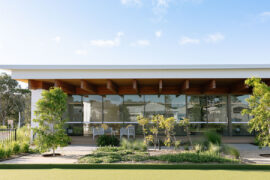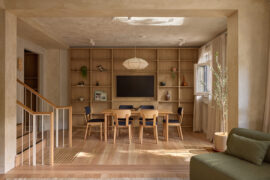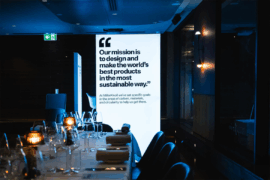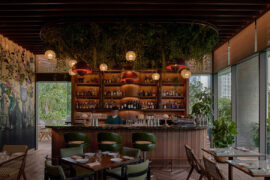Newly crowned as Head of Interiors Sydney at DKO, Laura Saunders took some time to talk minimalism and deceptive simplicity with Indesign.
After graduating from a Bachelor of Interior Architecture at the University of New South Wales in 2010, Laura Saunders packed up her life and moved down to Melbourne, unsure of where she’d live or work. Her first job outside of university was at one of Australia’s most prestigious architecture firms, DKO, which took her under its wing. She’s been there ever since.
Having honed her minimalist style and meticulous approach over nearly a decade in practice, Laura has recently been appointed to the lofty role of Head of Interiors Sydney at DKO. In the wake of her promotion, we sat down with Laura to talk the evolution of minimalism and the importance of breaking out of your comfort zone.
My tastes vary. A good designer shouldn’t have a style that they lock themselves into. But my style is quite minimalistic; I’d say I’m ‘classy meets minimal’. Authenticity is important to me, as is designing things that are crafted with attention to detail. But then, when I’m at work, I like to tailor our projects to the context that they’re in. That might mean pushing myself outside my normal style to achieve a better outcome; one that’s more responsive to the area that we’re in. I think a good designer needs to have that skill.
There are a lot of different interpretations and it’s up to the individual to see how far they want to push it. But it’s not about stripping everything back to its bare bones and hiding every sign of real life. For me, it’s about using restraint and encouraging purpose.
I think having a strong, simplistic form and a strong idea is paramount, and I would definitely restrain myself when I’m choosing materials and the colour palette. I might only use two or three colours and leave it at that. It’s also about honest detailing.
Minimalist detailing looks simple but is often the most complicated, because everything has to be hidden and designed down to the last millimetre. The design can’t look boring, either. It still needs to have a really strong idea behind it.
It all started as the grandchild of the Bauhaus movement. It was about rejecting the lavish and highly decorated styles of the past. If I can dumb it down, Bauhaus was about designing cheap and affordable items that looked nice. Mies van der Rohe summarised it well (and everyone knows this quote) when he said ‘less is more’.
The essence hasn’t really changed because the style has that timelessness to it, which is why designers keep coming back. It’s a classic style that almost always works. The simplicity of it makes it easy to incorporate into other styles and trends. The roots of the techniques stay the same, but the [application] will change as design preferences always do.
What I’m noticing now is that it’s not just about being a minimalist at home, or having a once-a-year spring clean, but that people are embracing it as a lifestyle – and through things like fashion and music as well. It’s a tool to rid yourself of life’s excess and focus on what’s important instead; it’s a lifestyle that helps people question what adds value to their lives. It might be the flavour of the month at the moment, but it does ebb and flow and it always makes its way back, because it is timeless.
We’re a residential architecture firm, so it’s really important to us in that sense. A multi-residential project needs to appeal to a broad market. Plus, if we design something now, it might not be built for another three or four years, so it’s important that it’s timeless and will look good for years to come.
We do a lot of retail and commercial work as well, and in the retail world, in particular, I’m seeing a trend towards ‘un-branding’, such as with Aēsop and Muji. These are brands with meticulous attention to detail and a clean, simple aesthetic. That simplicity comes from knowing the essence of every product, and the function of every component. That was really critical for Muji. DKO was responsible for Muji’s flagship store in Australia [in Chadstone], and we also did [the Muji stores in] the Emporium [Melbourne] and The Galeries in Sydney. For all of them, we used lots of raw materials like steel and timber. It was quite restrained; we describe it as poised somewhere between Aēsop and the stack-‘em-high utility of IKEA.
I think office space is another sector that’s been impacted by minimalism. People need space to think and they can do that [more easily] in a clutter-free environment. It’s about more than just having a tidy desk. An example is our DKO Sydney office, which is in the old Redfern Post Office. It’s a beautiful heritage building and there are all of these cosy, extravagant details, like a pressed tin metal ceiling. But we painted all of it white so it looks really crisp and quite relaxing. We’ve also made it quite modern with all the joinery that we’ve incorporated. When people come to our office, they always comment on how clean it all feels.
Context is our company ethos; we want to always relate back to the context that we’re working in. The first thing we do is look at the area in great detail; we look at the site and try to understand it and to understand the type of people who will be using the space. Then, we tailor our solution to meet that. It’s not a cookie-cutter approach; it’s about creating something bespoke and meaningful for every client.
Want more about minimalism? Take a look at Han Studio.
–
Get more stories like this straight to your inbox. Sign up for our newsletter.
INDESIGN is on instagram
Follow @indesignlive
A searchable and comprehensive guide for specifying leading products and their suppliers
Keep up to date with the latest and greatest from our industry BFF's!

London-based design duo Raw Edges have joined forces with Established & Sons and Tongue & Groove to introduce Wall to Wall – a hand-stained, “living collection” that transforms parquet flooring into a canvas of colour, pattern, and possibility.

Welcomed to the Australian design scene in 2024, Kokuyo is set to redefine collaboration, bringing its unique blend of colour and function to individuals and corporations, designed to be used Any Way!

Designed by DKO, the latest Ingenia Lifestyle Element resident clubhouses at Fullerton Cove and Natura at Port Stephens focus on the lifestyle needs of a changing over-55s demographic.

Queers in Property (QIP) NSW hosted a Pride Month event, Home Truths: Sydney’s Housing Crisis and the LGBTQIA+ Community, on Thursday 5th June 2025.
The internet never sleeps! Here's the stuff you might have missed

Merging residential living with the retail experience, the latest project from In Addition breathes new life into shopping for the home.

MillerKnoll reimagines the convention of dinner table interactions by plating up a future-forward menu of sustainable design conversation starters as part of the inspiring “Conversations for a Better World” event series.

On 6th September, Saturday Indesign lit up Melbourne with a day of immersive installations, design talks and showroom activations across three thrilling precincts.

Grounded by the rich warmth of American white oak, The Standard’s newly opened restaurant, Kaya, redefines the classic dining convention through a tasteful fusion of biophilic design, mid-century modern sensibility and elevated whimsy.